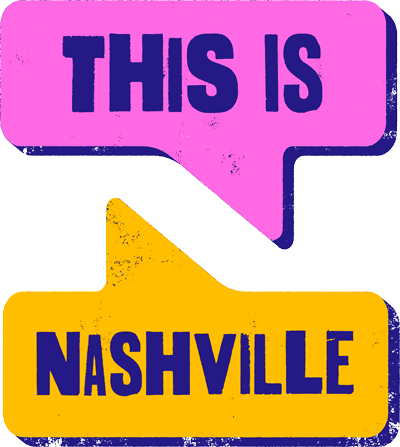
When WPLN Senior Music Writer Jewly Hight pitched me the idea for a This Is Nashville episode about roadside attractions, I was quick to say yes. But I was not prepared for the deep knowledge she had on the plethora of fun and quirky stops within Tennessee state lines. Luckily, I am an eager student and a good sport.
First thing to do: choose a destination. Do we go east or west? Do we investigate a new-to-Jewly destination like the Freshwater Pearl Museum, or stick to an attraction that is already guaranteed to be a good time? We settled on retracing a road trip to Brownsville that she had done a few years ago — out to the West Tennessee Delta Heritage Center, which includes the Tina Turner Museum. Pro tip: pre-game for this road trip by listening to Turner’s catalog of hits.
We met at Jewly’s house for the all-important task of choosing a road trip mascot from her collection of souvenir plushies. Evidently, the presence of a road trip mascot can turn a good roadtrip into a great roadtrip! I chose an 18-inch stuffed Willie Nelson doll, that Jewly bought at the Willie Nelson Museum near Opryland. We made our crucial first stop — snack acquisition — then headed west on Interstate 40.
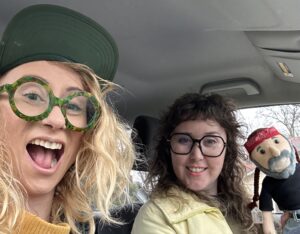 Jewly Hight WPLN
Jewly Hight WPLNJewly Hight and Magnolia McKay pose with their roadtrip mascot: stuffed Willie Nelson.
Jewly has made seeking and stopping at roadside attractions a lifestyle. Her house is decked out in fridge magnets, throw pillows and other memorabilia from roadside landmarks, strangely specific museums and other unique pit stops. It seems to me that she has more fun than most people who are stuck in a car for hours on end, and she let me in on how she does it. Among other trade secrets, she swears by the site RoadsideAmerica.com. It chronicles various “offbeat tourist attractions” that will provide you with a unique photo op, a good story and, hopefully, some fun merch. The site even has an app for iPhone or iPad, so you can map out attractions on your route. The roadside attractions lifestyle sparks a sort of giddy childlike sense of adventure, as if the best theme park of your life is waiting around the next corner for you. And it truly could be!
Am I doing this road trip thing right?
On the way to Brownsville, I thought, “Let me try this out.” I saw a sign for the Wonders Center and Science Museum, and my imagination ran wild! What kind of wonders could there be? Jewly mapped it and found that it was only a few miles off the highway, so we decided it was worth investigating. When we pulled up to what looked like a giant golf ball, I was delighted. But Jewly has a finely developed sense for kitsch and could tell right away that it wasn’t the quaint mom-and-pop museum we were hoping for.
“I think this is a Christian science museum,” she said. “Not Christian Science, but Christian… science museum.”
But the pit stop was fruitful after all. We gassed up, and I grabbed my favorite road snack — one I didn’t find at the health food store — sour gummies.
Back on the road, we met the four horsemen of the road trip apocalypse: traffic, having to hold it, boredom and roadkill. The first three ride together. The last is sort of a roadside jump scare, if you’re into that kind of thing. Stuck behind a Mack tractor-trailer, Jewly was looking forward to the next rest stop, and I brought up road games.
For our Gen Z readers, I must explain: There was a time long ago when the world was shrouded in darkness, there were only two types of Oreos — regular and double stuff — and a TV screen in a motor vehicle was pure fantasy. Only rich kids in movies had that, and it was always in a limo. Without smart phones, tablets or even a DVD player in the family minivan, we resorted to road games to pass the time. A road game is generally based on what one typically sees on the road. The staples in my family were Trucks — a cooperative game where you tally the makes of semis you see, and the most popular make by the end of the trip wins. Spoiler alert, it’s always Freightliner. We also played Cows — a high-stakes passenger side versus driver’s side cow-counting race to 100. And if your side of the highway has a cemetery, back to zero cows.
“But what if you’re on the driver’s side and your side of the highway is just a ditch, how do you get any cows?” Jewly asked.
The driver’s side includes the pastures beyond the other side of the highway. There are winners and losers in Cows, but no bad questions.
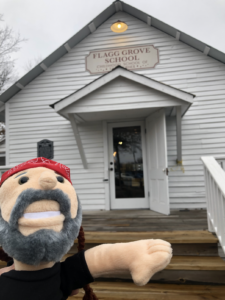 Magnolia McKay WPLN
Magnolia McKay WPLNWillie poses in front of Flagg Grove School in Brownsville, Tennessee.
Just off I-40, a stone’s throw from exit 56, we pulled up to a cream-colored brick building decked out in colorful murals of musicians. Sonia Outlaw-Clark, the executive director of the West Tennessee Delta Heritage Center and Tina Turner Museum, led us to the main attraction: Flagg Grove School. It’s a very simple one-room schoolhouse, painted white on the outside and wooden and rustic inside. It would be an unremarkable structure if it weren’t for the fact that this was where Tina Turner attended first through eighth grade. And as such — in addition to the antique cubbies, desks and chairs — it’s full of artifacts and memorabilia from her life and career.
The mane event
The museum has nine of Tina’s stage costumes, but only displays seven of them at a time. This is to let the threads rest in between their time in the spotlight. Did you know costumes get tired? I didn’t until Sonia told us.
When we asked Sonia to name her favorite, she pointed out the Mad Max costume. It’s a silver-colored chainmail dress with impressive shoulder pads, topped by a 3-foot-long wig. Sonia said the dress is 35 to 40 pounds and was designed for her to perform in for concerts because, if you can believe it, the identical dress that she wore in the movie was even heavier. The iconic metal coil earrings are built into the wig, which was a big relief for Sonia when the costume came in. “It was like, ‘Oh my gosh, her ears are saved!'”
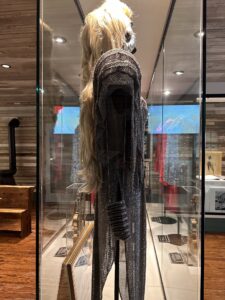 Jewly Hight WPLN
Jewly Hight WPLNTina Turner’s Mad Max concert costume is displayed at the Tina Turner Museum.
Fans of Tina will know about her humble beginnings from her song, “Nutbush City Limits.” But Sonia told us that calling it a city is a stretch. The schoolhouse Tina sings about on the main drag in Nutbush was only for white kids. Her school was several miles away in the Flagg Grove community. Flagg Grove School was named for Benjamin Flagg, Tina Turner’s great-uncle, who built it so that the Black children in the community could get an education.
But why is the school here, in Brownsville, instead of in a field miles away in unincorporated Nutbush? According to Sonia, that field’s farmer needed the land for an irrigation system. Similar to acquiring a used piano, he told the museum that he would donate the schoolhouse if they would pay the moving fees. The City of Brownsville footed that bill, and the restoration of the building was paid for by local and worldwide fans. The museum reached out to Tina Turner via her longtime friend and personal assistant Rhonda Graam, who still had the same telephone number from decades earlier. Shortly after that, Tina’s team sent the memorabilia and an architect and designer to put the exhibit together.
Gold and platinum records, sequined costumes and sky-high wigs radiate through glass cases in this simple schoolhouse that might otherwise be described as bare bones. Turns out, that dissonance was planned. Sonia said it was important to Tina to focus on this space as a place of education.
“And that we could see through the exhibits to those walls and those cubbies and those things that were already there,” Sonia said. “But she really wanted people to take away that it doesn’t matter what you come from. It’s up to you to reach for your dreams and to persevere and that you can make anything happen regardless.”
Before we left the schoolhouse, I noticed an old high school yearbook, opened to a page with a young Anna-Mae Bullock, Tina’s given name. Professions were written under each student’s name — how they hoped to earn a living in adulthood. Under Turner’s picture? Entertainer.
“The word was, around here, that if there was a stump she could turn over, she would get on it and perform — even at a very young age,” said Sonia.
Brownsville isn’t just Tina Turner
Jewly and I spent an hour in the schoolhouse, and then nearly another hour checking out the other areas the West Tennessee Delta Heritage Center has to offer. Next to the schoolhouse is a two-room shotgun shack that was the last home of pioneer bluesman Sleepy John Estes. A chance-sighting revived his career from obscurity in the 1960s and led to a world tour. We also saw the cotton room, complete with farm equipment and a diorama of a cotton gin building. The Hatchie River room, with a taxidermic alligator snapping turtle. Word is, if one of those clamps down on you, they don’t release until it thunders. This may be regional legend, but I have no interest in testing the theory. And the music room, which is full of pictures and memorabilia from the variety of musicians the region has produced — from Carl Perkins to early 2000s rock band Fuel.
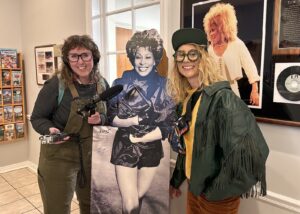 Sonia Outlaw-Clark
Sonia Outlaw-Clark Magnolia McKay interviews cardboard Tina Turner, while Jewly Hight supervises.
Jewly has a taxonomy of roadside attractions that she fully breaks down in our This Is Nashville episode. This includes the categories World’s Biggest Fill-in-the-Blank and The Super Specific Museum — like the American Museum of the House Cat in Sylva, North Carolina, or Gatlinburg’s Salt and Pepper Shaker Museum. The West Tennessee Delta Heritage Center falls into a third category: the Showcase of Regional Uniqueness or Industry. This category also includes Lodge’s Museum of Cast Iron in South Pittsburg, Tennessee, and the International Towing Museum in Chattanooga. Brownsville also offers a site that fits into Jewly’s fourth and perhaps favorite category: the Obsessive Project of a Solitary Visionary.
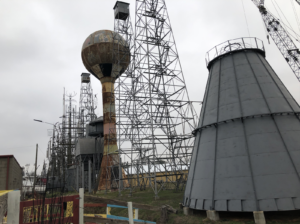 Magnolia McKay WPLN
Magnolia McKay WPLNBilly Tripp’s Mindfield in downtown Brownsville, Tennessee.
Just blocks away from Brownsville’s downtown square is a massive metal structure known as The Mindfield. At first glance it looks like an electric power plant. But a second look reveals that this is a work of art. Steel girders and scrap metal are welded together. Some of the scrap metal is recognizable: a boat, fire towers, a bulb-shaped water tower. And some has been turned into new shapes. The outline of the human body, hearts and hands can be spotted throughout The Mindfield.
The Solitary Visionary behind this project is Billy Tripp, a lifelong Brownsville resident who has been welding pieces of scrap metal together and putting them here since 1989, on this narrow strip of land that his father owned. Later, I spoke with his wife, psychologist Beth Tripp, on the phone. She said, early on, the city tried to stop him because he didn’t have a permit to put these massive sculptures downtown. But she said, in part because Brownsville is such a small community where everyone knows everyone else, they worked it out in a meeting, and the city decided to let him keep adding to the project.
But what does it all mean?
There are words and phrases peppered all through The Mindfield, most of them inscrutable. But Billy Tripp’s art is very personal to him. In interviews, he says that the art is a conversation with himself. He doesn’t mind if people overhear it but doesn’t feel obligated to explain it, either. For those who want to understand more fully, Beth points to his diaries, published into several volumes and available to purchase online. There’s also a newly-released documentary called “The Steel Garden,” by Brownsville-born filmmaker Randall Kendrick, which you can watch for free on YouTube.
Jewly’s description of the Obsessive Project of a Solitary Visionary is apt for The Mindfield. Beth told me that The Mindfield is Billy’s singular focus. Jewly could tell that just by looking at it.
“What I love about people who create huge folk art monuments like this is that they have this vision, and they just take it upon themselves to do this thing that is at such great scale,” Jewly said. “It just takes an obsessiveness and an outlandish creativity — a willingness to just go beyond what is ordinarily acceptable in terms of a thing to build, a thing to put in your yard.”
 Magnolia McKay WPLN
Magnolia McKay WPLNJewly Hight shares hers “Delta Dawn” milkshake with stuffed Willie Nelson at Livingston’s Diner in Brownsville, Tennessee.
Right next to The Mindfield is The Mindfield Grill, which unfortunately wasn’t open at the time of our visit. So we followed Sonia’s advice and stopped in at Livingston’s, a diner on the square, for dinner and one of their bodacious milkshakes before hitting the road home. Good company, snacks, games, intriguing stops and great photo ops — proof that you don’t have to go far or spend a lot of money to have a good road trip.
Check out this map of Jewly Hight-approved Tennessee roadside attractions, while you plan your next road trip:


